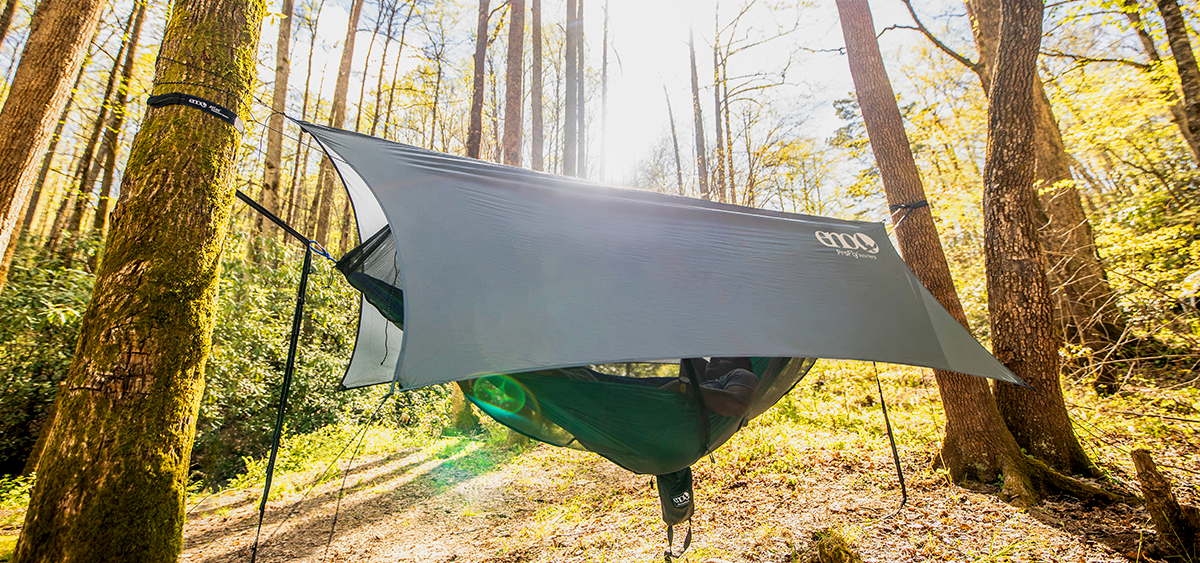Outdoor Shelter Options with ENO Hammocks
Written by Samarth Vasisht
Understanding what shelter system you want to use when backpacking can be an overwhelming and difficult decision. Here are some facts, pros and cons of each of the 4 primary systems to help make the process just a bit easier:
Tarps
Tarps are a great way to stay light as well as ensure that you are protected from the elements. This method of shelter was much more common in early camping because of its accessibility and simplicity. Most people who use tarps will use lightweight cuben fiber or sil-nylon tarps; but cheaper materials, such as simple painters’ tarps, can also be used for anyone on a budget. Tarps are usually set up using trekking poles and guy-lines to add stability to the structure. From my experience, this method of shelter is preferred by pure naturalists, people who want to stay lightweight, and people camping in insect-free environments. The pros of a tarp system are a light base weight as well as a minimalistic system that is less likely to have parts that fail. The downsides are that you have to deal with significant cross ventilation, as well as insects and other small animals.
Bivies
Bivy sacks or bivouac sacks are also considered a very simplistic mode of shelter. These sacks or full shelters are usually used only to cover your sleeping bag, which often makes them small and cramped. They are excellent for anyone going ultralight and allow for protection against most elements. Bivy sacks often create a system where either there is a small hood for where your face sticks out of your bag, or a small elevated section of the bivy that allows for complete coverage around the head and protection from the elements. The pros for bivy’s are the obvious weight savings as well as protection from insects that tarps cannot offer. The downsides are that bivy’s often get very cramped and allow for very little ventilation in hot or humid environments.
Tents
Tents are probably the most traditional shelter option that most backpackers travel with. Most tents are freestanding, give plenty of room as well as privacy, come in a large variation of sizes, shapes, and costs and provide a stable shelter that makes camping possible for a wide range of people. With backpacking, the diverse range of tents usually becomes a lot smaller but still provides the most options compared to any other shelter option. For a backpacking tent, it’s important to keep a couple things in mind. First, if you’re not camping with your significant other or you just like having personal space, it’s important to go up by one in size of tent (i.e. if you’re camping with two people, get a “3 person” tent). Second, it’s important to keep the weight of your tent as close to 3 lbs./person as possible. Obviously you can get lighter than this, but for a comfortable trip it’s nice to stay within that range. Third, it’s important to choose a tent that is within your price range and also durable. Tents take a lot of abuse over the years, so it’s important to take good care of your tent and go with a brand that stands behind its products. If you plan on going camping during snowy winter months, plan on getting a 4-season tent for winter durability; but if not, buy a well-ventilated 3-season tent. Before backpacking, air out your tent and ensure that you don’t forget the poles! (It happens to all of us) Pros of a tent include a very deep marketplace that provides many options, a relatively large, well-protected shelter, and the ability to camp anywhere there is flat ground. The negatives of buying a tent are usually the price as well as the lack of interchangeable options. It is also very difficult to reduce the weight of a tent without spending thousands of dollars on advanced materials.
Hammocks
Hammocks are an old shelter system that have gained a lot of popularity as of recently because of the mass production of lightweight hammocks. Hammocks are wonderful for camping because they are small, packable and light. They also allow you to camp almost anywhere – the surface and terrain of the trail do not matter because you’re suspended off the ground. Camping with hammocks allows you to mix and match your “hammock system” in order to have a shelter system that is ideal for the conditions you are entering. For an effective backpacking hammock system, it’s important to have a hammock, tarp, and insulation system. I personally use an ENO DoubleNest, because it’s great to have the extra fabric to wrap around you when you’re sleeping. Plus, the DoubleNest is easy to set up anywhere. When sleeping in a hammock, it is important to remember to lie diagonally so that your back remains straight. Researchers in Geneva have actually conducted research and concluded that sleeping in a hammock allows you to get a better night of sleep due to the rhythmic rocking of the hammock! ENO also provides many tarp options, which allow you to stay out of the rain and still keep your system very light. With insulation, you have two options: you can use a sleeping pad and a sleeping bag in order to stay warm or an under/top quilt system to stay warm. If you choose to take the sleeping bag/pad option, the Hot Spot is a great way to keep your pad from slipping underneath you and to ensure that your shoulders stay warm. Underquilts work by maintaining a layer of insulation underneath the hammock that keeps you warm without you compressing it. Based on warmth needs, the combination of a Vulcan UnderQuilt and an Vesta TopQuilt is an easy and light way to stay warm during winter backpacking. And if you’re short on funds, a great way to create a winter set-up is to take an old sleeping bag and make your own underquilt using some simple DIY techniques. So in conclusion, the pros of a hammock include lightweight setups, many options, and comfort. The cost of a good hammock system can also be reduced using DIY setups until you can upgrade to better sleep systems. The downsides of a hammock are usually related to the lack of trees or mounting locations, although this can be overcome with the careful use of posts and climbing nuts around rocky terrain. I personally use a hammock camping system when I camp and absolutely love being able to end a long day of hiking by relaxing in my hammock!





Share:
Stay Warm Sleeping Under the Stars
Backpacking Checklists